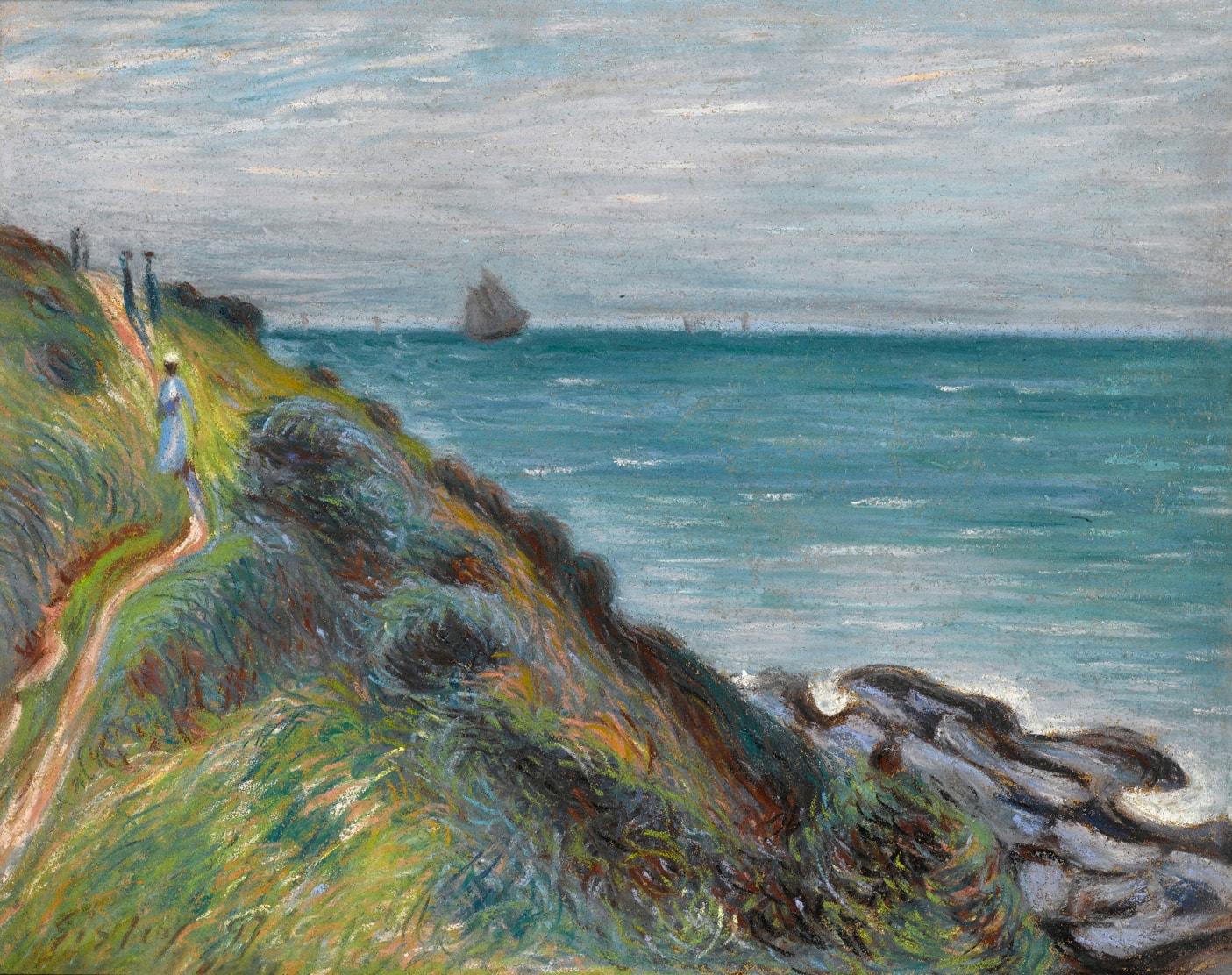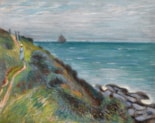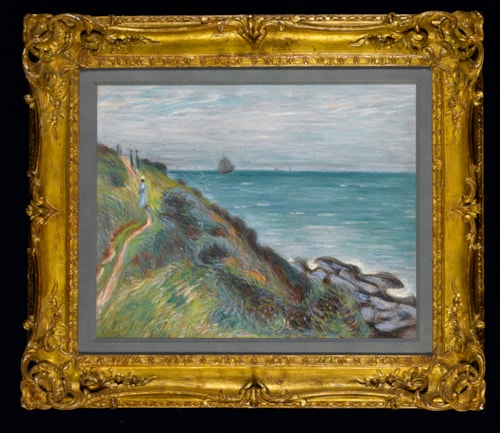Alfred SISLEY
(Paris 1839 - Moret-sur-Loing 1899)
The Cliffs at Langland Bay, Wales
Sold
Pastel.
Signed and dated Sisley 97 at the lower left.
289 x 365 mm. (11 3/8 x 14 3/8 in.)
Signed and dated Sisley 97 at the lower left.
289 x 365 mm. (11 3/8 x 14 3/8 in.)
Although some nine hundred paintings by Sisley are known, his oeuvre includes only a very few drawings, of which the handful of pastel landscapes – most of which are datable to the 1880’s and 1890’s - are the most significant. As Richard Shone has noted, ‘As a medium, pastel was new in Sisley’s work, but he took to it with mastery...Sisley’s pastels are entirely of landscapes.’ These works display the artist’s consummate mastery of the pastel medium, as can be seen in this magnificently fresh and vibrant coastal scene, drawn near the end of Sisley’s life.
In the summer of 1897, and possibly with the financial support of the Rouen collector François Depeaux (1853-1920), who had coal-mining interests in Wales, Sisley was able to spend four months travelling and working in Britain; this was to be his final visit to his ancestral country. After spending a brief time in London and the South of England, he visited South Wales, where he remained for the rest of his stay. Based at Penarth, a seaside resort town at the southern end of Cardiff Bay, Sisley produced five paintings of views in the area.
On August 5th he married his long-time companion Eugénie Lescouezec in Cardiff, and from Penarth the couple moved west along the Gower coast to Swansea, where they spent their honeymoon at the Osborne Hotel in the holiday resort town of Langland Bay.
This vibrant pastel view of Langland Bay, which is in remarkably fresh condition, is closely related to Sisley’s painting of the same view, dated 1897, which is today in a private collection. Both views were probably painted from a window of the Osborne Hotel overlooking the Bay. In a letter to his friend Adolph Tavernier, sent on the 18th of August 1897, soon after arrival at the hotel, Sisley wrote ‘I have been here for five days. The countryside is totally different from Penarth, more hilly, and on a larger scale. The sea is magnificent and the subjects are interesting. But you have to fight hard against the wind, which reigns supreme here. I had not experienced this nuisance before, but I am getting used to coping with it and have already discovered the knack. I think I shall wait till the bad weather drives me away, because there is plenty to do here.’
In the summer of 1897, and possibly with the financial support of the Rouen collector François Depeaux (1853-1920), who had coal-mining interests in Wales, Sisley was able to spend four months travelling and working in Britain; this was to be his final visit to his ancestral country. After spending a brief time in London and the South of England, he visited South Wales, where he remained for the rest of his stay. Based at Penarth, a seaside resort town at the southern end of Cardiff Bay, Sisley produced five paintings of views in the area.
On August 5th he married his long-time companion Eugénie Lescouezec in Cardiff, and from Penarth the couple moved west along the Gower coast to Swansea, where they spent their honeymoon at the Osborne Hotel in the holiday resort town of Langland Bay.
This vibrant pastel view of Langland Bay, which is in remarkably fresh condition, is closely related to Sisley’s painting of the same view, dated 1897, which is today in a private collection. Both views were probably painted from a window of the Osborne Hotel overlooking the Bay. In a letter to his friend Adolph Tavernier, sent on the 18th of August 1897, soon after arrival at the hotel, Sisley wrote ‘I have been here for five days. The countryside is totally different from Penarth, more hilly, and on a larger scale. The sea is magnificent and the subjects are interesting. But you have to fight hard against the wind, which reigns supreme here. I had not experienced this nuisance before, but I am getting used to coping with it and have already discovered the knack. I think I shall wait till the bad weather drives me away, because there is plenty to do here.’
Born in Paris into an Anglo-French family, Alfred Sisley achieved relatively little commercial success and public recognition during his lifetime. Throughout his career his style remained true to the most basic Impressionist principles, without recourse to the technical or thematic development characteristic of the later work of such fellow artists as Claude Monet, Camille Pissarro and Pierre-Auguste Renoir. He also remained resolutely devoted to the practice of pure landscape painting, working en plein-air throughout his career. As Christopher Lloyd has noted, unlike Monet, Renoir and Pissarro in the 1880’s and 1890’s, Sisley ‘continued to explore the possibilities of the Impressionist style from within, retaining the same approach to nature and in this sense remaining a true Impressionist painter concerned with light, colour and atmosphere…it is this unswerving allegiance to Impressionism beyond the 1870’s that is the most distinctive feature of his work.’
Sisley worked for much of his early career in towns and villages to the north and west of Paris, including Bougival, Louveciennes, Sèvres and Port-Marly, before eventually settling in the 1880’s at Moret-sur-Loing, well to the southeast of the city. Although not always appreciated by critics, Sisley was nevertheless much liked and admired by many of his fellow artists. As Pissarro wrote to his son Lucien in 1899, ‘Sisley…is a great and beautiful artist, in my opinion he is a master equal to the greatest. I have seen works of his of rare amplitude and beauty…’ At Sisley’s funeral, the collector and critic Adolphe Tavernier gave an oration in which he praised the artist as ‘a painter exquisite and original among them all, a magician of light, a poet of the heavens, of the waters, of the trees – in a word, one of the most remarkable landscapists of this day.’
Provenance
The Lefevre Gallery, London
Anonymous sale (‘The Property of a Lady of Title’), London, Christie’s, 7 July 1961, lot 48 (as Lady’s Cove, Wales)
Anonymous sale, London, Christie’s, 30 June 1987, lot 322
Tzwern-Aisinber Fine Arts, Brussels, in 1989
Anonymous sale, London, Sotheby’s, 28 June 1995, lot 124
Private collection, France, until 2013.
Literature
‘Books of the Day’, The Illustrated London News, January 16, 1937, p.107, illustrated (as Cliffs at Hastings); Brussels, Tzwern-Aisinber Fine Arts, Le Cercle des XX, exhibition catalogue, 1989, pp.262-263, no.68, illustrated in colour p.110; Vivienne Couldrey, Alfred Sisley: The English Impressionist, Newton Abbot, 1992, illustrated p.65; Richard Shone, Sisley, London, 1992, p.193, pl.153; Nicholas Reed, Sisley on the Thames and the Welsh Coast, Folkestone, 2008, p.W24; ‘Bay leaves an impression’, South Wales Evening Post, 5 November 2011, illustrated; To be included in the forthcoming supplement to the Sisley catalogue raisonné by the late François Daulte and the Comité Alfred Sisley.
Exhibition
London, The Lefevre Gallery, Pissarro and Sisley, January 1937, no.29 (as Falaises à Hastings); London, The Lefevre Gallery, British and French Paintings, 1942, no.22; London, The Lefevre Gallery, XIX and XX Century French Paintings, March-April 1957, no.19 (as Hastings); Brussels, Tzwern-Aisinber Fine Arts, Le Cercle des XX, 1989, no.68.





